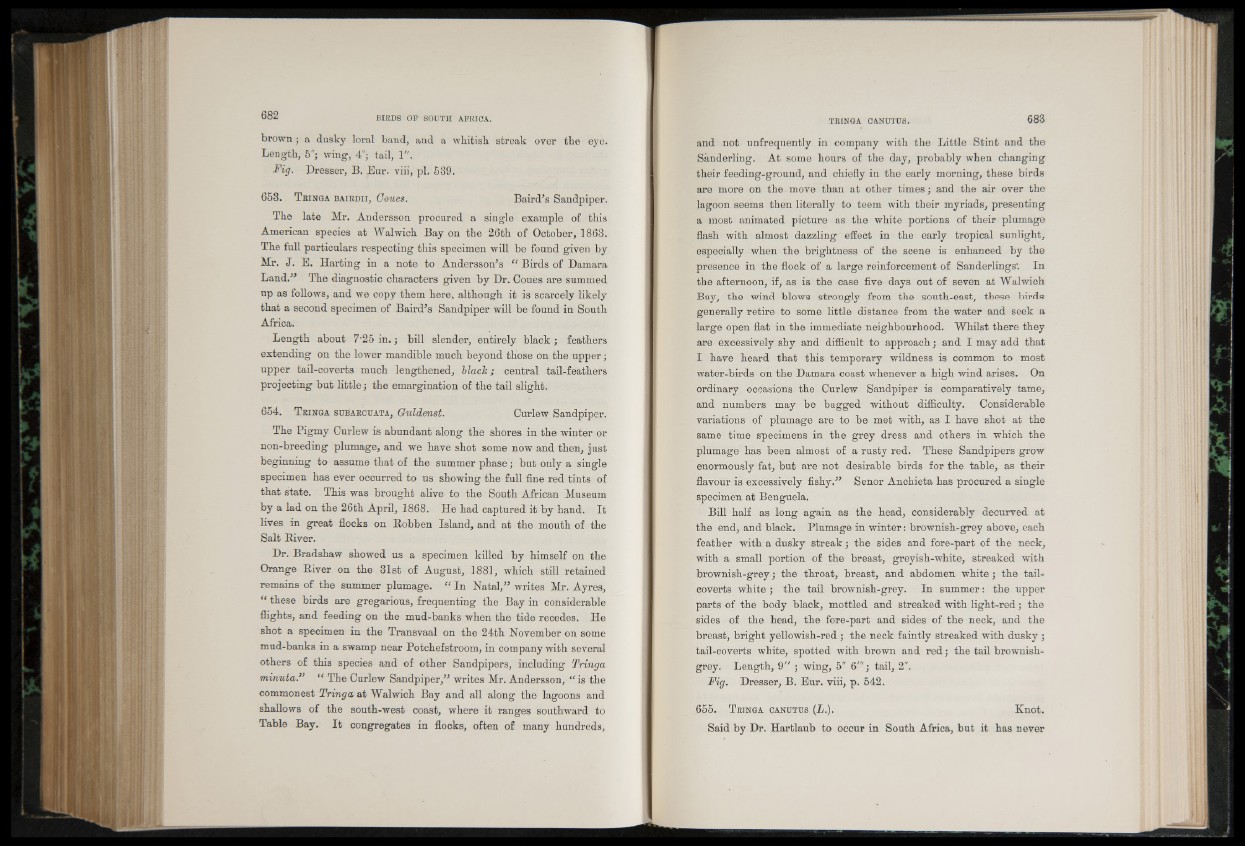
brown ; a dusky loral band, and a whitish streak over the eye.
Length, 5"; wing, 4"; tail, 1".
Fig. Dresser, B. Eur. viii, pi. 539.
653. T r in g a b a i r d i i , Goues. Baird’s Sandpiper.
The late Mr. Andersson procured a single example of this
American species at Walwich Bay on the 26th of October, 1863.
The full particulars respecting this specimen will be found given by
Mr. J . E. Harting in a note to Andersson’s “ Birds of Damara
Land.” The diagnostic characters given by Dr. Coues are summed
up as follows, and we copy them here, although it is scarcely likely
that a second specimen of Baird’s Sandpiper will be found in South
Africa.
Length about 7-25 in.; bill slender, entirely black ; feathers
extending on the lower mandible much beyond those on the upper;
upper tail-coverts much lengthened, Hack; central tail-feathers
projecting but little ; the emargination of the tail slight.
654. T r in g a s u b a r c u a t a , Guldenst. Curlew Sandpiper.
The Pigmy Curlew is abundant along the shores in the winter or
non-breeding plumage, and we have shot some now and then, just
beginning to assume that of the summer phase; but only a single
specimen has ever occurred to us showing the full fine red tints of
that state. This was brought alive to the South African Museum
by a lad on the 26th April, 1868. He had captured it by hand. It
lives in great flocks on Robben Island, and at the mouth of the
Salt River.
Dr. Bradshaw showed us a specimen killed by himself on the
Orange River on the 31st of August, 1881, which still retained
remains of the summer plumage. “ In Natal,” writes Mr. Ayres,
“ these birds are gregarious, frequenting the Bay in considerable
flights, and feeding on the mud-banks when the tide recedes. He
shot a specimen in the Transvaal on the 24th November on some
mud-banks in a swamp near Potchefstroom, in company with several
others of this species and of other Sandpipers, including Tringa
minutaT “ The Curlew Sandpiper,” writes Mr. Andersson, “ is the
commonest Tringa at Walwich Bay and all along the lagoons and
shallows of the south-west coast, where it ranges southward to
Table Bay. I t congregates in flocks, often of many hundreds,
and not unfrequently in company with the Little Stint and the
Sanderling. At some hours of the day, probably when changing
their feeding-ground, and chiefly in the early morning, these birds
are more on the. move than at other times; and the air over the
lagoon seems then literally to teem with their myriads, presenting
a most animated picture as the white portions of their plumage
flash with almost dazzling effect in the early tropical sunlight,
especially when the brightness of the scene is enhanced by the
presence in the flock of a large reinforcement of Sanderlings*. In
the afternoon, if, as is the case five days out of seven at Walwich
Bay, the wind blows strongly from the south-east, these birds
generally retire to some little distance from the water and seek a
large open flat in the immediate neighbourhood. Whilst there they
are excessively shy and difficult to approach; and I may add that
I have heard that this temporary wildness is common to most
water-birds on the Damara coast whenever a high wind arises. On
ordinary occasions the Curlew Sandpiper is comparatively tame,
and numbers may be bagged without difficulty. Considerable
variations of plumage are to be met with, as I have shot at the
same time specimens in the grey dress and others in which the
plumage has been almost of a rusty red. These Sandpipers grow
enormously fat, but are not desirable birds for the table, as their
flavour is excessively fishy.” Senor Anchieta has procured a single
specimen at Benguela.
Bill half as long again as the head, considerably decurved at
the end, and black. Plumage in winter: brownish-grey above, each
feather with a dusky streak; the sides and fore-part of the neck,
with a small portion of the breast, greyish-white, streaked with
brownish-grey; the throat, breast, and abdomen white; the tail-
coverts white ; the tail brownish-grey. In summer: the upper
parts of the body black, mottled and streaked with light-red; the
sides of the head, the fore-part and sides of the neck, and the
breast, bright yellowish-red ; the neck faintly streaked with dusky ;
tail-coverts white, spotted with brown and red; the tail brownish-
grey. Length, 9” ; wing, 5" 6'"; tail, 2".
Fig. Dresser, B. Eur. viii, p. 542.
655. T r in g a c a n d t u s (L.). Knot.
Said by Dr. Hartlaub to occur in South Africa, but it has never